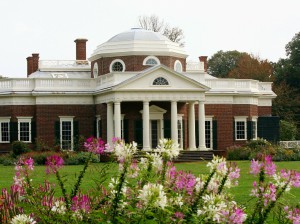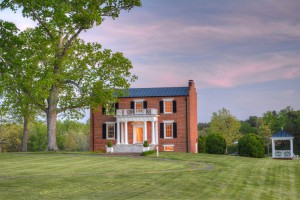As the first of England’s colonies in the world, the state of Virginia essentially represents the beginning of the British Empire, and its legacy is consequently inextricable from that of the early United States. As such, it is home to a number of historical sites that represent British imperialism, American independence, and so much more.
Jeffersonian Architecture

Thomas Jefferson was America’s first Secretary of State, Virginia’s second governor, and the third President of the United States. He was a voracious reader, elite musician, legendary statesmen, and overall polymath. As such, it is difficult to overstate his influence in a number of areas, not least architecture. His architectural sensibilities were derived in large part from the work of Venetian architect Andrea Palladio, who himself drew from a variety of Hellenistic influences. The symmetry and perspective of Ancient Greek and Roman buildings inspired Palladio’s approach to architecture, and as such, buildings designed by Jefferson retain certain core values…certain ideas inherited from Ancient Greek and Roman temples. This structural approach, this Neoclassical interpretation can be seen in a variety of buildings around Virginia, most notably Jefferson’s plantation Monticello and the Rotunda at his University of Virginia. Jefferson helped conceive the original design for the Virginia State House.
Jefferson designed/influenced several other buildings, for example, Poplar Forest, located very close to Lynchburg….they say he built it as a refuge from the hordes of admirers that flocked to Monticello. Like much of Palladio’s work, it is an octagon house, built on an estate of about 4,800 acres. This architectural tradition prizes symmetry, so there is a cube room in the center (20 ft. to a side, so 400 square feet), and porticos off to each side. It received National Historic Landmark status in 1970. There are many other central Virginia sites that serve to illustrate the state’s rich history:

Oak Grove was once part of the vast Mount Airy plantation on the James River, and was occupied by Union General Sheridan’s troops in the Civil War. Built about 1854, Oak Grove is today a tasteful composite of vintage quality and modern comfort, with the original brick home in front, a three-story addition in back. It’s a three bay, two-story house, conceived in the Greek Revival style with front porch Doric columns. Listed on the National Register of Historic Places in 2009.
Ash Lawn-Highland, the old home of fifth President of the United States is in Albemarle County. He and his family lived there for 24 years, eventually selling the plantation in 1825. He was inspired by Monticello, which is very close by. The estate changed hands a few times until it was sold for the last time in the 1930s. When the owner died, he willed it to the College of William and Mary, Monroe’s alma mater. It was added to the National Register of Historic Places in 1973.
The Faulkner House, which houses the Miller Center for Public Affairs and is also known as Old Ivy Inn, Seymour (and various others), was named in honor of novelist William Faulkner who taught at UVa. Built between 1855 and 1856 and remodeled in the early 20th century in the Colonial Revival style, it was influenced in part by Jeffersonian architectural inclinations. Originally a two-story brick building with hipped roof. Temporary headquarters for Union General Thomas Devin. On Old Ivy Road. It was bought by UVa in 1963 and added to the NHRP in 1984.
Farmington is a country club near UVa, in Charlottesville. It was designed and built before the 19th century, but in 1803, Thomas Jefferson added an east wing, later dubbed “the Jefferson room.” It features trademark Jeffersonian concepts, most notably the octagonal structure. It was added to the National Register of Historic Places in 1970.
Bellair Farm is an 853-acre farm south of Charlottesville, on land near the North Garden area. It’s been an important part of Albemarle County’s history since it first started operations in the 17th century. The main house was built in the late 19th/early 20th century by Reverend Charles Wingfield, Jr. So great was Wingfield’s reputation that Jefferson personally asked him to officiate the funeral of his sister. Further structural additions were made to the main house in the Colonial Revival style (including some Palladian windows). The house overlooks the Hardware River and the Green Mountains, a beautiful sight. The farm is still in operation today, and its owner Ms. Cynnie Davis is an outspoken proponent of community-supported agriculture. It was added to the National Register of Historic Places in 1992.
Michie Tavern was originally on land in Earlysville, Virginia, just north of Charlottesville. It was built in 1784 by Scotsman Willie Michie and remained in the family until the early 20th century. The tavern was a community meeting place, popular among travelers. It was added to the Virginia Landmarks Register in 1993 and the NRHP in 1986, though it’s since been withdrawn from the latter.
McCormick Observatory was a donation to UVa from Leander McCormick, whose family invented and patented the mechanical reaper. In 1878, McCormick donated the telescope (at the time the equal largest telescope in the country) and funds to build a 45-foot dome. It’s just outside Charlottesville, in Albemarle County on the summit of Mt. Jefferson (also known as Observatory Hill). Joined the ranks of the NRHP in 2004 and was soon upgraded from state to national significance.

Cobham Park is one of many historic estates in Keswick, just east of Charlottesville. The estate’s mansion was built in 1856, and unlike many of the surrounding buildings of similar historical stature, it was built in the Georgian style, with Doric porches supported by Ionic columns. It’s a five bay, two-and-a-half story building with a hipped roof. It was added to the NHRP in 1974.
Nelson County, in the Greater Charlottesville area, is also rife with historical significance. It’s known for its snow resort Wintergreen, a plethora of successful vineyards, craft breweries, the Lockn’ Music Festival, and many testaments to its natural beauty including part of the George Washington National Forest. It’s also home to:
Swannanoa is Virginia’s answer to the Taj Mahal, a luxurious, ornate manifestation of love. The difference is that when philanthropist James H. Dooley built it, his wife was still alive. Tiffany windows, Georgian marble, gold plumbing fixtures, and 300 artisans working for over eight years…we’d say that Swannanoa is worth a look. It sits on 590 acres of land in Nelson/Augusta Counties, but it’s partially modeled after buildings in the Villa Medici, in Rome. Calvin Coolidge famously ate Thanksgiving dinner here. Anyone can arrange for a tour of the estate…check the events calendar at http://nelsoncounty.com NHRP in 1969.
Nelson County’s Courthouse, opened in 1810 and has been the judicial center of Lovingston, VA ever since. This two-story building was built just two or three years after the town itself was established. For years, rumor had it that Jefferson designed the building, but this myth was dispelled by an architectural survey as part of the county’s bid for National Historic Register designation. However, it was discovered that Jefferson had designed a jail, which is now the present-day Sheriff’s Office. Many 18-22-year-olds in central Virginia view it as a smaller, more efficient version of his most famous jailhouse, the University of Virginia…but only during Exams Week. The courthouse was listed on the NHRP in 1973.
Bon Aire is yet another historic home in Nelson, located in the city of Shipman. It was built in the Federal style and as such is characterized by the simple, relatively unadorned surfaces and smooth facades of early U.S. buildings whose architects were influenced by the Roman aesthetics very much in vogue after the ruins of Pompeii and Herculaneum were discovered. It was built in 1812 on a steep hill overlooking the James River. It was added to the NHRP in 1980.
Orange County was founded in 1734, over forty years before the Declaration of Independence was even a gleam in young Jefferson’s eye! It’s best known as the home of fourth President of the United States, James Madison.
Montpelier. We may as well start with James Madison’s sprawling, 2,700-acre plantation. Madison inherited the original building from his father, who built it around 1764; two stories of brick, laid in the Flemish bond pattern. It had many resources, i.e. smithy and tobacco crops. Madison was especially proud of the estate and added extensions to it throughout his life, including a Tuscan portico and single-story flat-roofed extensions to create separate living quarters. Madison died in 1836, and he is still buried in the family cemetery. Montpelier was owned by the Du Pont family for most of the 20th century. In 1984, the National Trust for Historic Preservation took over, aiming to restore/recreate the site’s 19th-century conditions, when James and Dolley Madison owned it. This is the result of a $25 million restoration effort. Montpelier is a National Historic Landmark and became an entry on the National Register of Historic Places in 1966.
Barboursville (also known as the Barboursville Ruins), is famous for being the only building in Orange County designed by Thomas Jefferson himself. There are hallmarks of his Palladian instincts, as they were quite fashionable at the time (1822). The house had eight huge rooms, including an octagonal drawing room reminiscent of Monticello. He envisioned a projecting Doric tetrastyle portico which covered a recessed front wall at the entry hall. Ol’ TJ had designed it for his friend James Barbour, a famous former Senator, Secretary of War, and VA Governor who had ostensibly planned to live in the mansion for the rest of his days. Unfortunately, the entire estate burned in a fire on Christmas Day in 1824. Everything except for the exterior walls, some partitions, and the portico columns was consumed in the blaze. Now the ruins are part of the property owned by Barboursville Vineyards, and you can see the old mansion from the vineyards. Barboursville Vineyards is widely considered the poster-child for Virginia’s burgeoning viticultural reputation. The terroir in the Piedmont region is similar to places in southern Italy, but Gianni Zonin (the resident winemaker) is so far the only person to successfully plant the common grape vine in central VA since Jefferson famously failed years ago. NHRP in 1969, due in large part to Jefferson’s role in designing the ruin.
Grelen is one of the youngest buildings in the area to be considered a National Historic Place (1998). The five bay, two-and-a-half story building was built between 1935 and 1936 in the Georgian style. It’s topped by a hipped roof made of slate and flanked by one-and-a-half story wings (also brick).
The centuries before this digital age, were not as kind to mankind’s memory. Landmarks and historic sites were more than a few clicks away; they could be miles, sometimes oceans removed from your perspective. For many, these ornate monuments bridged a gap in America’s collective unconscious, provided a tangible link between the struggles and triumphs of a young nation and the distant legends of antiquity. A journey across the Atlantic to see the hallowed relics of Greek and Roman societies is not necessarily a viable option for everyone in today’s America; so one can imagine the significance of buildings in which the spirit, tradition, and aesthetic of antiquity are preserved imparted. These larger-than-life buildings were and are mirrors to the past; more so than any film or photograph could ever be. This is only the surface of Virginia’s rich history. If you’re interested in living a part of this history, visit www.CharlottesvilleHistoricHomes.com or contact Gayle Harvey Real Estate today!

